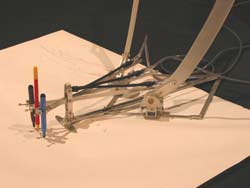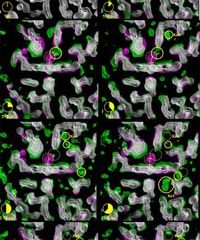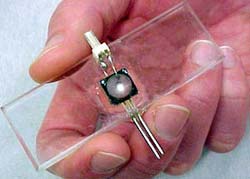Interdisciplinary Research
News and developments from the field of interdisciplinary research.
Among other topics, you can find stimulating reports and articles related to microsystems, emotions research, futures research and stratospheric research.

Researchers use lab cultures to create robotic ’semi-living artist’
Working from their university labs in two different corners of the world, U.S. and Australian researchers have created what they call a new class of creative beings, “the semi-living artist” – a picture-drawing robot in Perth, Australia whose movements are controlled by the brain signals of cultured rat cells in Atlanta.
Gripping three colored markers positioned above a white canvas, the robotic drawing arm operates based on the neural activity of a few thousand rat neurons placed in a spec

Filming an ultra-fast biological reaction essential to life
A team of scientists from the USA in collaboration with staff at the European Synchrotron Radiation Facility (Schotte et al) have managed to film a protein at work in unprecedented detail. The protein is the oxygen-storing molecule myoglobin, which plays a central role in the production of energy in muscles. The motion of the protein was recorded using ultra-short flashes of X-ray light from the synchrotron. The new insight in the functionality of myoglobin has led to a deeper understanding of the m

Scientists build a bridge for new bone
Biodegradable scaffold significantly increases the rate of bone healing
University of Toronto scientists have developed a biodegradable scaffold, similar in structure to a dish sponge, that significantly speeds the rate of bone healing.
The material, developed by an interdisciplinary team with expertise in engineering, biology, chemistry and dentistry, provides a building scaffold for bone growth. The scaffold, which eventually dissolves, increases healing rates and offers

Deciphering how arteries contribute to hypertension
National Insitute of Standards and Technology (NIST) scientists are taking their knowledge of mechanical tensile strength tests in metals and composites and applying it to medical research problems. Doctors long have known that babies born with congenital heart defects at higher altitudes have an increased risk of developing complications, such as pulmonary hypertension. Could there be some way to trick the arterial walls so that they wouldn’t stiffen under increased blood pressure?
Wo

Researchers combine electronics with living cell to create potential toxicity sensor
In experiments conducted at the University of California, Berkeley, researchers have found a way to tap into the telltale electrical signals that mark cell death, opening the door to the creation of a “canary on a chip” that can be used to sound the alarm of a biochemical attack or test drug toxicity on human tissue.
In a study appearing in the June 15 issue of Sensors and Actuators, researchers used a microchip to electrically determine cell viability by detecting changes in the electrica

Biocompatibility to Ensure Body Friendly Parts
In recent years, the solution to the problem of diseased or damaged organs has been to replace the old with the new. By taking tissue from either a patient or a donor, surgeons have transplanted this to the damaged area and given many people a new lease of life.
The method is not without limitations, however. Issues such as the availability of donor organs and the need to use drugs to prevent the immune system rejecting the “foreign” tissue have prompted research into alternative ways to d